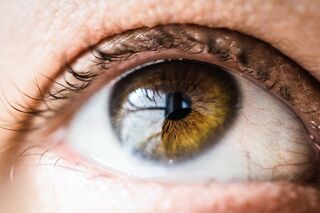Attention
How to Tell If People Are Paying Attention on Zoom
Watch the eyes for the giveaway.
Posted May 10, 2021 Reviewed by Kaja Perina
Key points
- Zoom meetings differ from real life conversations in terms of perceptual information.
- Judging gaze direction on Zoom probably won't tell you much about whether others are paying attention.
- You can tell whether someone is paying attention to the conversation by counting their blinks.

We’ve all been there: you’re on a long Zoom meeting with several other people, and your attention starts to wander. You click over to read your email, or Twitter, or the news—but, as long as you aren’t sharing your screen, it’s ok because no one can see, right? There could still be a way for someone to tell if you are paying attention.
Eye gaze can be misleading.
People sometimes try to judge attentiveness on Zoom by tracking other people’s gaze—what, you wonder, is that person looking at? This is only natural. We humans are supremely sensitive to where other people’s eyes are pointing since this usually indicates where someone’s attention is directed. In fact, the white of the eye in humans, called the sclera, likely evolved as a way to make it easier to judge where other people are looking. The uniformly starch-white color makes our darker irises and pupils stand out, helping our brains work out where someone's eyes are pointed. Our chimpanzee cousins are less reliant on inferring where others’ attention lies, and it is probably no accident that they have a range of sclera colors in the wild, ranging from dull white to brown.

Our eyes are white precisely because inferring attention is such valuable information. More than anything, perhaps, we want to know if someone is paying attention to us during a conversation.
Can watching people’s gaze on Zoom help us judge whether they are paying attention to the conversation or reading something else? Unfortunately not. There isn’t an alignment of eye gaze and attention as there is in real life. Since webcams sit above the screen where your attention is focused, you won't be looking directly at someone when you are paying attention to them. And your video box may be on different parts of the screen for different Zoom-mates. Plus, one could be taking notes on another screen all while paying good attention and engaging in the conversation.
It's also tough to catch people reading by tracking gaze. Video resolution is also generally not good enough to record the characteristic side-to-side scanning we perform during reading (but be aware that this can sometimes be noticeable).
So you will probably just be confused—and distracted—if you are assessing attention by trying to figure out where someone's eyes are pointed, or how their eyes are moving.
But there’s another way. The secret is blinking. We automatically blink several times a minute. This serves partly to keep the delicate cornea moisturized. But we blink more than is strictly necessary for maintaining a healthy cornea. About two or three blinks per minute would suffice but we often blink a lot more.
Though it is counter-intuitive, blanking out the world more often seems to enhance visual perception. There is now a wealth of evidence that we blink more when we are paying close attention. And few tasks require more focused attention than a conversation.
The Importance of Blink Rate
During a conversation we blink around twice as much as when doing other tasks like reading. In the language of the brain-as-computer metaphor, the blink gives our brain a brief "refresh" after which it can make a better analysis of what we just saw. Under the internet metaphor of the brain that I advocate, a blink might be better seen as a moment for your brain to find a more effective route for the information from your eye through your brain, a route that extracts more information in an ever-changing visual world.
When people are not paying attention to the Zoom meeting, it’s probably because they are reading something else. Unless they are muted, they are probably not listening to a podcast or watching a video. So we have a neat trick to see if someone is paying attention: count blinks. If someone blinks around ten times over the course of a minute, they are probably paying close attention to the conversation. If they blink about 4 or 5 times a minute, they are probably reading something else, and not paying attention to the Zoom. Even counting blinks over 30 seconds may be good enough—look for five or so from someone paying attention to the conversation, and two or three from those who are not.
A caveat is that there is as yet no direct evidence that counting blinks will tell you whether someone is paying attention on Zoom. However, this is largely because attention is difficult to measure. Researchers at Dublin City University tried this experiment recently, but could not clearly support the hypothesis that people blinked more while paying attention on Zoom. But this is probably not because the hypothesis is false—it’s because the hypothesis is hard to test. Although it is now easy to detect and count blinks even on low-res video, the researchers found, like many others before, that measuring attention in real-time is very difficult. The problem is that it is almost impossible to pay attention to something and also record that you are paying attention at the same time. The participants being on Zoom makes things even harder. More research is surely needed, but I think it is likely the blink hypothesis will be borne out, at least in certain types of Zoom meetings, such as team/committee meetings. If, despite their quirks, Zoom meetings can be considered true human conversations, there is every reason to believe that we will deploy the same attentional resources—and blink patterns—as we do in real-life conversations.
Another caveat is that, as you’re counting blinks, others may notice you are blinking less, and therefore not paying attention to the conversation. So I recommend deploying this technique discretely, or better yet on recorded meetings when no one will know.
Thanks to David Field, who is full of good ideas. Copyright © 2021 Daniel Graham. Unauthorized reproduction of any content on this page is forbidden. For reprint requests, email reprints@internetinyourhead.com.
References
Ang, J. W. A., & Maus, G. W. (2020). Boosted visual performance after eye blinks. Journal of Vision, 20(10), 2-2.
Gurche, J. (2013). Shaping Humanity: How Science, Art, and Imagination Help Us Understand Our Origins. Yale University Press.
Lee, H., Liu, M., Riaz, H., Rajasekaren, N., Scriney, M., & Smeaton, A. F. (2021). Attention Based Video Summaries of Live Online Zoom Classes. Presented at AAAI-2021 Workshop on AI Education: "Imagining Post-COVID Education with AI" (TIPCE-2021). arXiv preprint arXiv:2101.06328.


